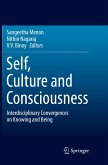Francine Tremblay
Self, Identity, and Collective Action
Francine Tremblay
Self, Identity, and Collective Action
- Gebundenes Buch
- Merkliste
- Auf die Merkliste
- Bewerten Bewerten
- Teilen
- Produkt teilen
- Produkterinnerung
- Produkterinnerung
Returning to the much-neglected work of George Herbert Mead, this book defines the self and links it to identity and collective action.
Andere Kunden interessierten sich auch für
![Self, God and Immortality Self, God and Immortality]() Eugene FontinellSelf, God and Immortality108,99 €
Eugene FontinellSelf, God and Immortality108,99 €![Self, Other, and the Weight of Desire Self, Other, and the Weight of Desire]() Niklas ToivakainenSelf, Other, and the Weight of Desire97,99 €
Niklas ToivakainenSelf, Other, and the Weight of Desire97,99 €![Self, Culture and Consciousness Self, Culture and Consciousness]() Self, Culture and Consciousness105,99 €
Self, Culture and Consciousness105,99 €![Invisible machines. Collective action through digital space Invisible machines. Collective action through digital space]() Edmund ZagorinInvisible machines. Collective action through digital space52,95 €
Edmund ZagorinInvisible machines. Collective action through digital space52,95 €![Self, Other, and the Weight of Desire Self, Other, and the Weight of Desire]() Niklas ToivakainenSelf, Other, and the Weight of Desire97,99 €
Niklas ToivakainenSelf, Other, and the Weight of Desire97,99 €![The Psychology of Tzimtzum: Self, Other, and God The Psychology of Tzimtzum: Self, Other, and God]() Mordechai RotenbergThe Psychology of Tzimtzum: Self, Other, and God23,99 €
Mordechai RotenbergThe Psychology of Tzimtzum: Self, Other, and God23,99 €![New Conversations on the Problems of Identity, Consciousness and Mind New Conversations on the Problems of Identity, Consciousness and Mind]() Jonathan O. ChimakonamNew Conversations on the Problems of Identity, Consciousness and Mind41,99 €
Jonathan O. ChimakonamNew Conversations on the Problems of Identity, Consciousness and Mind41,99 €-
-
-
Returning to the much-neglected work of George Herbert Mead, this book defines the self and links it to identity and collective action.
Hinweis: Dieser Artikel kann nur an eine deutsche Lieferadresse ausgeliefert werden.
Hinweis: Dieser Artikel kann nur an eine deutsche Lieferadresse ausgeliefert werden.
Produktdetails
- Produktdetails
- Verlag: Lexington Books
- Seitenzahl: 186
- Erscheinungstermin: 29. August 2023
- Englisch
- Abmessung: 241mm x 158mm x 19mm
- Gewicht: 472g
- ISBN-13: 9781666908114
- ISBN-10: 1666908118
- Artikelnr.: 68175885
- Herstellerkennzeichnung
- Libri GmbH
- Europaallee 1
- 36244 Bad Hersfeld
- gpsr@libri.de
- Verlag: Lexington Books
- Seitenzahl: 186
- Erscheinungstermin: 29. August 2023
- Englisch
- Abmessung: 241mm x 158mm x 19mm
- Gewicht: 472g
- ISBN-13: 9781666908114
- ISBN-10: 1666908118
- Artikelnr.: 68175885
- Herstellerkennzeichnung
- Libri GmbH
- Europaallee 1
- 36244 Bad Hersfeld
- gpsr@libri.de
By Francine Tremblay
Table of Contents
Acknowledgments
Introduction
-The Appearance of Identity in Our Vocabulary
-Theoretical Framework and Epistemological Choices
-René Descartes and Modernity
-Émile Durkheim and the Individual
-Conversations Procedures
Chapter One: Theoretical Framework
-George Herbert Mead and the Genesis of the Self
-Historical Notes
-The Mind: Undoing Dualism
-Language: From Gestures to Symbols
-Building the Self
-The Making of the Unique Self
-Action: The Moment of I Become an Actor
-Moral Identity: Who I Am is Defined by What I Do
-Autonomy
-Reduction of Suffering
-Everyday Life
-Moral Identity: A Work in Progress
-The Luxury of Introspection
-Recognition
Chapter Two: The Making of Marginalized Identities: From the French
Revolution to Now
-The French Revolution and the Aftermath
-The Problem of Representation
-The Masses as Numbers
-La Misère
-Organized Workers
-Madness
-Industrialization
-Sexuality
-Drug Scares
-Power
-Identities and the Medical Discourse
-Race, Self and Identity
Chapter Three: The Virtual Selves
-Playing with Reality
-The Self and the New Panopticon
-The Worldwide Shopping Mall
-Virtual Discussion and Moral Identity
-Online Activism
-Discussion
Chapter Four: Self, Identity and Collective Action
-Resource Mobilization Theory (RMT)
-New Social Movement Theory (NSMT)
-Identity and Framing
-Actors and Collective Identity
-Emotion: Time to Give the Untamed Element its Rightful Place
-Mobilization - the Statues are Down. Now What?
Conclusion: A Conversation with James Dalton
-Theory
-Technology and Social Media
Bibliography
About the Author
Acknowledgments
Introduction
-The Appearance of Identity in Our Vocabulary
-Theoretical Framework and Epistemological Choices
-René Descartes and Modernity
-Émile Durkheim and the Individual
-Conversations Procedures
Chapter One: Theoretical Framework
-George Herbert Mead and the Genesis of the Self
-Historical Notes
-The Mind: Undoing Dualism
-Language: From Gestures to Symbols
-Building the Self
-The Making of the Unique Self
-Action: The Moment of I Become an Actor
-Moral Identity: Who I Am is Defined by What I Do
-Autonomy
-Reduction of Suffering
-Everyday Life
-Moral Identity: A Work in Progress
-The Luxury of Introspection
-Recognition
Chapter Two: The Making of Marginalized Identities: From the French
Revolution to Now
-The French Revolution and the Aftermath
-The Problem of Representation
-The Masses as Numbers
-La Misère
-Organized Workers
-Madness
-Industrialization
-Sexuality
-Drug Scares
-Power
-Identities and the Medical Discourse
-Race, Self and Identity
Chapter Three: The Virtual Selves
-Playing with Reality
-The Self and the New Panopticon
-The Worldwide Shopping Mall
-Virtual Discussion and Moral Identity
-Online Activism
-Discussion
Chapter Four: Self, Identity and Collective Action
-Resource Mobilization Theory (RMT)
-New Social Movement Theory (NSMT)
-Identity and Framing
-Actors and Collective Identity
-Emotion: Time to Give the Untamed Element its Rightful Place
-Mobilization - the Statues are Down. Now What?
Conclusion: A Conversation with James Dalton
-Theory
-Technology and Social Media
Bibliography
About the Author
Table of Contents
Acknowledgments
Introduction
-The Appearance of Identity in Our Vocabulary
-Theoretical Framework and Epistemological Choices
-René Descartes and Modernity
-Émile Durkheim and the Individual
-Conversations Procedures
Chapter One: Theoretical Framework
-George Herbert Mead and the Genesis of the Self
-Historical Notes
-The Mind: Undoing Dualism
-Language: From Gestures to Symbols
-Building the Self
-The Making of the Unique Self
-Action: The Moment of I Become an Actor
-Moral Identity: Who I Am is Defined by What I Do
-Autonomy
-Reduction of Suffering
-Everyday Life
-Moral Identity: A Work in Progress
-The Luxury of Introspection
-Recognition
Chapter Two: The Making of Marginalized Identities: From the French
Revolution to Now
-The French Revolution and the Aftermath
-The Problem of Representation
-The Masses as Numbers
-La Misère
-Organized Workers
-Madness
-Industrialization
-Sexuality
-Drug Scares
-Power
-Identities and the Medical Discourse
-Race, Self and Identity
Chapter Three: The Virtual Selves
-Playing with Reality
-The Self and the New Panopticon
-The Worldwide Shopping Mall
-Virtual Discussion and Moral Identity
-Online Activism
-Discussion
Chapter Four: Self, Identity and Collective Action
-Resource Mobilization Theory (RMT)
-New Social Movement Theory (NSMT)
-Identity and Framing
-Actors and Collective Identity
-Emotion: Time to Give the Untamed Element its Rightful Place
-Mobilization - the Statues are Down. Now What?
Conclusion: A Conversation with James Dalton
-Theory
-Technology and Social Media
Bibliography
About the Author
Acknowledgments
Introduction
-The Appearance of Identity in Our Vocabulary
-Theoretical Framework and Epistemological Choices
-René Descartes and Modernity
-Émile Durkheim and the Individual
-Conversations Procedures
Chapter One: Theoretical Framework
-George Herbert Mead and the Genesis of the Self
-Historical Notes
-The Mind: Undoing Dualism
-Language: From Gestures to Symbols
-Building the Self
-The Making of the Unique Self
-Action: The Moment of I Become an Actor
-Moral Identity: Who I Am is Defined by What I Do
-Autonomy
-Reduction of Suffering
-Everyday Life
-Moral Identity: A Work in Progress
-The Luxury of Introspection
-Recognition
Chapter Two: The Making of Marginalized Identities: From the French
Revolution to Now
-The French Revolution and the Aftermath
-The Problem of Representation
-The Masses as Numbers
-La Misère
-Organized Workers
-Madness
-Industrialization
-Sexuality
-Drug Scares
-Power
-Identities and the Medical Discourse
-Race, Self and Identity
Chapter Three: The Virtual Selves
-Playing with Reality
-The Self and the New Panopticon
-The Worldwide Shopping Mall
-Virtual Discussion and Moral Identity
-Online Activism
-Discussion
Chapter Four: Self, Identity and Collective Action
-Resource Mobilization Theory (RMT)
-New Social Movement Theory (NSMT)
-Identity and Framing
-Actors and Collective Identity
-Emotion: Time to Give the Untamed Element its Rightful Place
-Mobilization - the Statues are Down. Now What?
Conclusion: A Conversation with James Dalton
-Theory
-Technology and Social Media
Bibliography
About the Author








